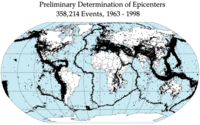
Photo from wikipedia
The existing artificial intelligence model uses single-point logging data as the eigenvalue to predict shear wave travel times (DTS), which does not consider the longitudinal continuity of logging data along… Click to show full abstract
The existing artificial intelligence model uses single-point logging data as the eigenvalue to predict shear wave travel times (DTS), which does not consider the longitudinal continuity of logging data along the reservoir and lacks the multiwell data processing method. Low prediction accuracy of shear wave travel time affects the accuracy of elastic parameters and results in inaccurate sand production prediction. This paper establishes the shear wave prediction model based on the standardization, normalization, and depth correction of conventional logging data with five artificial intelligence methods (linear regression, random forest, support vector regression, XGBoost, and ANN). The adjacent data points in depth are used as machine learning eigenvalues to improve the practicability of interwell and the accuracy of single-well prediction. The results show that the model built with XGBoost using five points outperforms other models in predicting. The R2 of 0.994 and 0.964 are obtained for the training set and testing set, respectively. Every model considering reservoir vertical geological continuity predicts test set DTS with higher accuracy than single-point prediction. The developed model provides a tool to determine geomechanical parameters and give a preliminary suggestion on the possibility of sand production where shear wave travel times are not available. The implementation of the model provides an economic and reliable alternative for the oil and gas industry.
Journal Title: Mathematical Problems in Engineering
Year Published: 2021
Link to full text (if available)
Share on Social Media: Sign Up to like & get
recommendations!